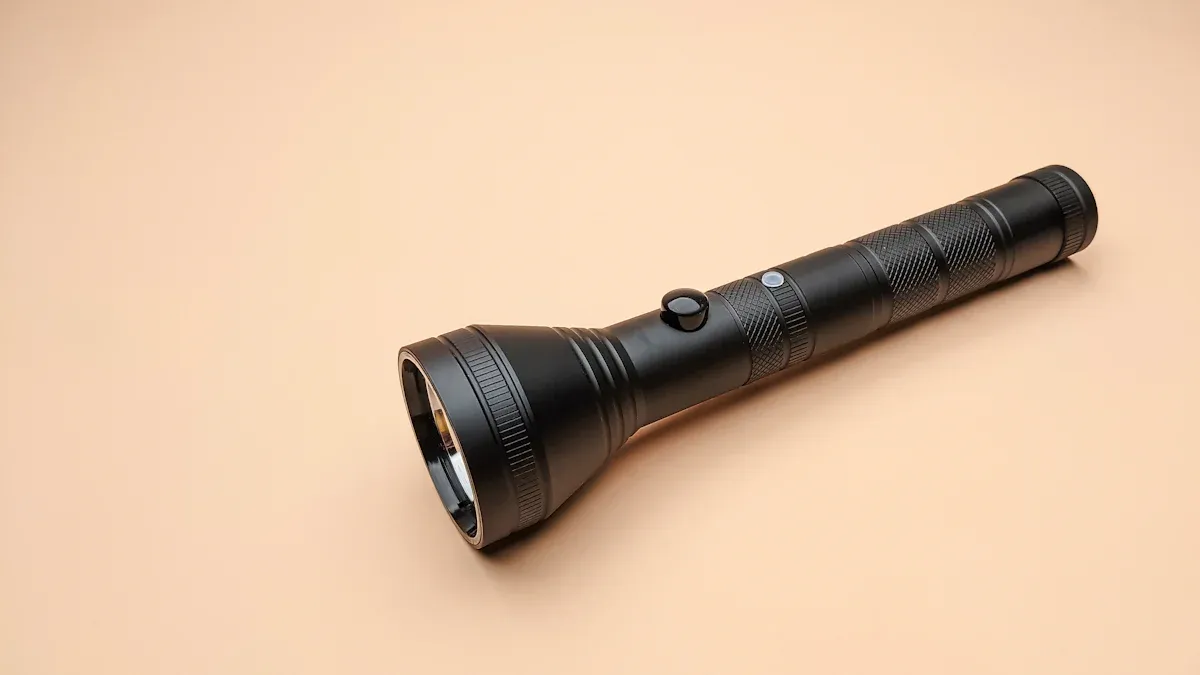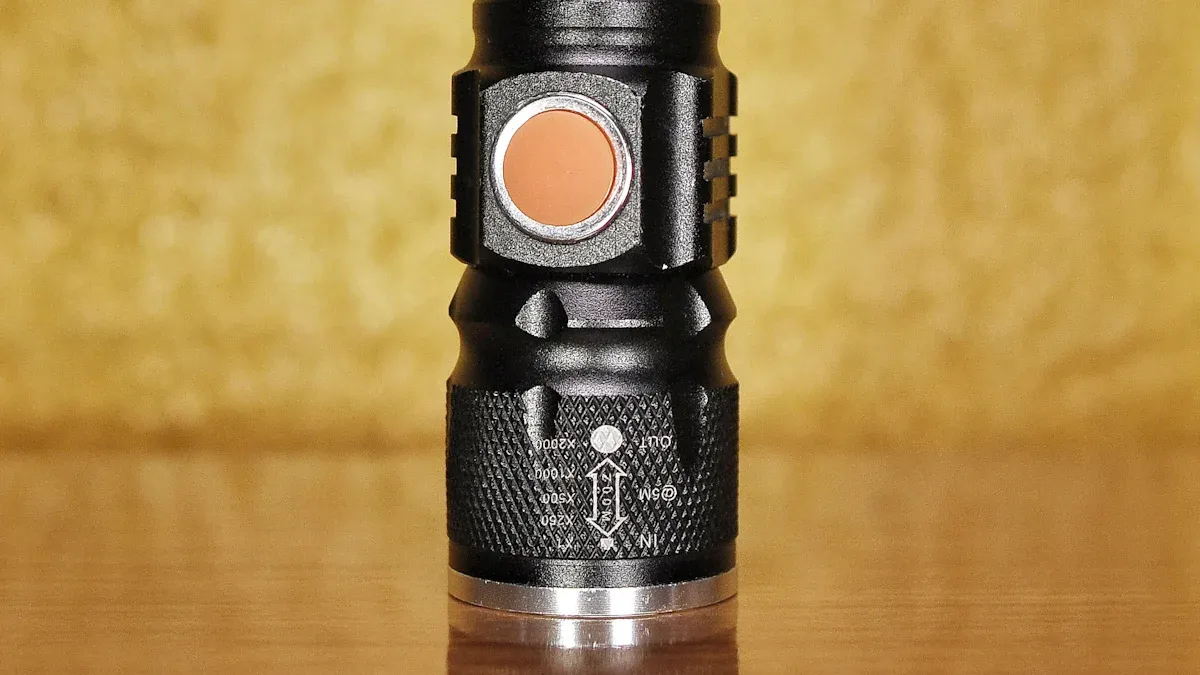How Bright Should Your Flashlight Be for Daily Tasks?

When doing daily tasks, the right flashlight, such as the Helius flashlight, helps a lot. Most tasks need a flashlight with 150-500 lumens. Whether walking at night, reading, or during emergencies, brightness depends on the task. For example:
Night walks need 150-300 lumens to see paths clearly.
Industrial jobs may need 1000-3000 lumens for good lighting.
Hiking trails might require up to 2000 lumens for safety.
Picking a dependable flashlight like the Helius flashlight keeps you prepared.
Key Takeaways
Pick a flashlight with 150-500 lumens for daily use. This brightness works well for walking at night or reading.
For emergencies, get a flashlight with 1,000 lumens or more. It helps you see clearly in very dark or risky places.
Think about the flashlight's size and weight. A small one is easy to carry, but a bigger one gives more light.
What Are Lumens and Why Do They Matter?
Understanding Lumens as a Measure of Brightness
When you shop for a flashlight, you’ll often see the term "lumens" on the packaging. But what does it mean? Lumens measure the total amount of visible light a flashlight produces. Think of it as the "brightness score" of the light output. The higher the lumens, the brighter the flashlight.
For example, a flashlight with 100 lumens is great for indoor use, like finding something under your couch. On the other hand, a flashlight with 500 lumens or more can light up a backyard or a trail at night. This makes lumens an essential factor when choosing the right flashlight for your needs.
How Lumens Affect Flashlight Performance
The number of lumens doesn’t just determine brightness—it also affects how you perceive light in different environments. Here’s why:
The same lumens can feel brighter in a dark room than in daylight.
Your eyes adjust to darkness by dilating pupils, making light seem more intense.
Cooler-toned light (bluish-white) appears brighter than warmer tones (yellowish).
Surrounding colors and lighting conditions can change how bright the flashlight seems.
This means a flashlight with 300 lumens might feel perfect for a nighttime walk but too dim for a foggy outdoor hike. A flashlight lumens chart can help you match the right brightness to your activity. Remember, more lumens don’t always mean better—it’s about finding the right balance for your task.
Recommended Lumens for Common Daily Tasks

Indoor Tasks and Reading
For indoor tasks like reading or finding things, you don’t need a very bright flashlight. A flashlight with 50-150 lumens is just right. It gives enough light without hurting your eyes. Be careful with very bright flashlights indoors. They can make your eyes uncomfortable or even blind you for a moment if pointed directly at them. Older flashlights used to get hot, but modern LED ones are safer and cooler to use.
Walking at Night or Around the House
When walking at night or moving around your house in dim light, a flashlight with 10-60 lumens is usually enough. Many people think 30 lumens is a good mix of brightness and keeping your night vision. On very dark nights, even 10-12 lumens can help you see without ruining your natural night vision. For paths or trails you know well, 50 lumens should work fine.
Emergency Preparedness and Power Outages
In emergencies, you need a flashlight that is bright and dependable. A flashlight with at least 1,000 lumens will help you see clearly in dark or dangerous situations. Look for features like rechargeable batteries, water resistance, and strong materials like aluminum. These make the flashlight reliable when you need it most.
Outdoor Activities Like Camping or Hiking
For camping or hiking, a flashlight with 100-1,000 lumens works well. If you’re setting up a tent or cooking outside, 400 lumens is a good balance of brightness and saving battery. Small flashlights with 100-400 lumens are easy to carry and lightweight. Brighter ones can light up bigger areas, keeping you safe on the trail.
Work-Related Tasks and High-Intensity Needs
For work tasks, you need a strong and tough flashlight. Flashlights with 1,000 to 3,000 lumens are great for these jobs. They shine wide, bright beams to light up big spaces, so you don’t miss anything. Some have magnetic bases and adjustable angles, making them handy for work. Strong designs and rechargeable batteries make them perfect for tough jobs.
Picking the Best Flashlight for Your Needs
Battery Life and Power Source
You need a flashlight with enough battery life for your tasks. Here are some things to think about:
Runtime: This shows how long the flashlight works on one charge or set of batteries. For short tasks, a medium runtime is fine. For emergencies or long trips, choose one with a longer runtime.
Brightness Settings: Flashlights with adjustable brightness help save battery. Use lower settings when full brightness isn’t needed.
Power Source Options: Rechargeable batteries are better for the environment and save money over time. Disposable batteries, like AA or AAA, are easy to replace quickly.
Tip: Batteries act differently in extreme weather. Cold makes them weaker, and heat drains them faster.
Here’s a simple comparison of battery types:
Battery Type | Pros | Cons |
|---|---|---|
AA/AAA | Cheap and easy to find. | Don’t last as long. |
Rechargeable Lithium | Lasts longer and eco-friendly. | Costs more at first. |
123A | Small but powerful. | Expensive and harder to find. |
Flashlight Size and Portability
The size of a flashlight matters. Small flashlights are easy to carry in a pocket or bag. Bigger ones give more light but weigh more. Choose a lightweight flashlight that balances size and power.
Beam Type: Focused vs. Wide
The beam type changes how you use the flashlight. A focused beam is great for seeing far away, like across a field. A wide beam lights up bigger areas, perfect for close tasks or camping. Some flashlights let you switch between the two for more options.
Did you know? A focused beam with high lumens reaches farther than a wide beam.
Durability and Weather Resistance
If you’ll use your flashlight outside or in rough places, it needs to be tough. Look for strong materials like aluminum or hard plastic. These last longer and handle wear. Rubber seals keep water and dust out, so the flashlight works in bad weather.
Here’s a guide to common IP ratings for weatherproof flashlights:
IP Rating | What It Means |
|---|---|
IP65 | Resists water sprays and low-pressure jets. |
IP67 | Keeps out dust and can go underwater up to 1 meter for 30 minutes. |
IP68 | Fully dustproof and works underwater for longer and deeper. |
Pro Tip: Flashlights with special aluminum coatings don’t rust, making them great for wet places.
Tips for Using Your Helius Flashlight Efficiently
Adjusting Brightness Settings
Using the right brightness saves energy and battery life. Here are some simple tips:
Switch Modes: Use low brightness for reading. Use high brightness for outdoors or emergencies.
PWM Feature: This saves energy by quickly turning the light on and off.
Smooth Dimming: Flashlights with current regulation dim better and save power.
Energy-Saving Circuits: These help your flashlight last longer by reducing energy waste.
Battery Protection: Low-voltage protection keeps batteries healthy and ready to use.
Pro Tip: Use the lowest brightness you need. It saves battery and is easier on your eyes.
Maintaining Your Flashlight for Longevity
Take care of your Helius flashlight to keep it working well. Follow these steps:
Keep Water Out: Use silicone grease on seals to block moisture.
Check Batteries: Recharge or replace them often. Remove them if storing for a long time.
Clean Contacts: Wipe dirt off the contacts to stop flickering.
Lubricate Parts: Add silicone grease to threads and switches to avoid rust.
Store Safely: Keep your flashlight in a cool, dry place. Avoid very hot or cold areas.
Common Problem: If your flashlight flickers, clean the battery contacts. If it still doesn’t work, check the switch or replace the batteries.
By following these tips, your Helius flashlight will stay reliable for all your tasks.
A flashlight with 150-500 lumens is good for daily use. For reading or walking, 10-150 lumens is enough light. Pick small, strong flashlights with brightness you can adjust. Flashlights like the Fenix E03R V2.0 are easy to carry and have different settings. The right flashlight keeps you prepared for anything.
FAQ
What flashlight brightness is best for kids?
A flashlight with 10-50 lumens works well for kids. It’s bright enough for safety but won’t hurt their eyes.
Tip: Choose lightweight, easy-to-hold flashlights for children.
Can I use a flashlight in extreme weather?
Yes, but pick one with an IP67 or IP68 rating. These flashlights resist water and dust, making them reliable in harsh conditions.
How do I know when to replace flashlight batteries?
Replace batteries when the light dims or flickers. Rechargeable models often have indicators to show when they need charging.
Pro Tip: Always carry spare batteries for emergencies.
See Also
Comparing Police Flashlights and Regular Ones: Which Wins?
Discover Your Ideal Flashlight for Daily Use
Understanding Flashlight Lumens: Your Complete Brightness Resource
